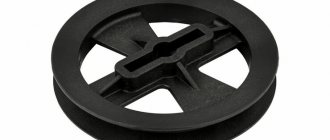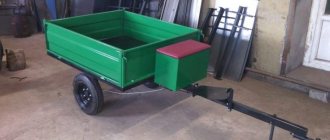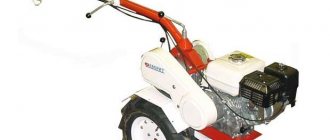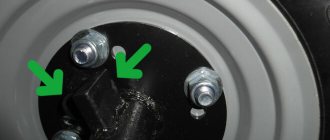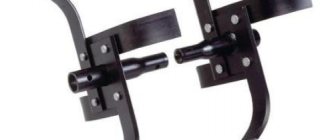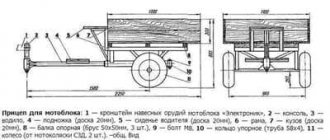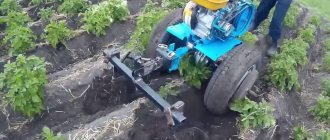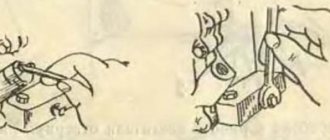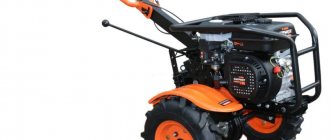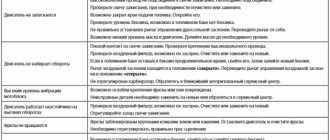The pulley is the component of the walk-behind tractor that is responsible for transmitting revolutions from the engine to the attachments. Typically, energy transfer occurs through a belt. Using a pulley, you can also control the rotation of the attachments of the walk-behind tractor. We will tell you in more detail about some of the technical characteristics and about the independent production of this part.
Pulley from a walk-behind tractor: purpose and types
A pulley for a walk-behind tractor is a part that looks like a small wheel.
Usually installed between shafts. Due to the belt drive, it creates rotational movements between them. Therefore, the walk-behind tractor pulley is the main mechanism that can be used to change the torque of any technical device, be it a cultivator or a sawmill. Walk-behind pulleys differ in:
- material performance;
- size;
- number of streams;
- type of mounting holes.
The pulley for the walk-behind tractor is most often made from:
Lighter options made of plastic or pressed sawdust are possible. For this spare part, the diameter is both external and internal. Pulley sizes are standardized to eliminate confusion in this matter. According to current standards, pulleys for walk-behind tractors are:
- monolithic - diameter up to 10 cm;
- disc - 4-8 cm;
- equipped with knitting needles - 18-100 cm in diameter.
For pulleys of different sizes, the landing grooves, although present in approximately the same number (about 8), are different in shape:
Their number usually does not exceed 8
Based on the fact that the maneuverability of a walk-behind tractor is determined by the transfer of the belt between streams, the subtypes of pulleys are:
Also, depending on which shaft it belongs to, the pulley is classified into:
For example, the driven pulley on a walk-behind tractor is designed to communicate with the motor and bring auxiliary equipment into working condition. The driven one is installed directly on the crankshaft.
Pulley concept
It is designed to transmit torque from the drive shaft to the driven shaft. To operate such a drive, both shafts are placed in parallel. A flat wheel is put on and secured to each shaft; they are placed in the same plane. The wheels are connected by an endless flexible drive belt. When the drive pulley rotates, the friction force causes the belt to move, covering part of its surface. This motion is transferred to the driven pulley, causing it to rotate.
Belt drives are common among household appliances, mechanisms of low- and medium-power machine tools, and in various internal combustion engines.
It has the following advantages:
- simple device;
- the ability to transmit significant power, modern V-belt pairs transmit up to 400 kW;
- high rotation speed, up to 50 m/s;
- smooth and quiet running;
- damping of vibrations and jerks of the drive shaft during rotation transmission;
- slippage under overloads acts as a safety mechanism.
The pulley itself is a disk on a shaft. It consists of two main parts: the rim and the hub. The rim is the outer part of the part. It engages with the belt and, depending on the type of drive, can be flat or have a recess in the shape of the belt. The side projections above the rim are called cheeks. They keep the belt from slipping. If the drive is wedge, then the cheeks are made inclined; they have an additional function - they increase the engagement area.
If a gear drive is used, then teeth of the appropriate shape are made on the surface of the rim.
If several streams are used in parallel, several grooves are made on the rim.
The hub is the inner part of the pulley. It has a hole for mounting on the shaft. Often the rim and hub are cast, turned, or milled as a single piece.
To reduce the weight of the product, voids are left in the body of the pulley, forming spokes. When made from wood, the presence of knitting needles was determined by the manufacturing technology.
To ensure the interchangeability of pulleys, their standard sizes, technological requirements, and markings are standardized. They are described in GOST 20889-94. “Pulleys for driving V-belts” and in GOST R 50641-94 (ISO 4183-89).
Standard markings include the following parameters:
- number of streams;
- profile of the drive belt used;
- diameter (calculated by cord);
- sleeve designation.
Thus, the marking 8 SPC 500 indicates an eight-lane pulley for an SPC profile with a diameter of 500 mm.
The rules for depicting pulleys in the drawing have also been standardized. The drawing must be constructed so that the product can be manufactured to exactly the same shape and size.
Pulley for a walk-behind tractor engine: learning to make it yourself
In order to perform this seemingly difficult task at home and do without purchasing this part, there are a number of ways. We will focus on a few - the simplest and most universal ones, which will help replace a worn spline pulley both on walk-behind tractors of the Neva series and others - such as the Salyut and Centaur.
1st method
The trick of the first method is to directly turn the part using a previously made workpiece on a lathe. The absence of turning equipment at home is not an obstacle to the successful completion of the project, since turning products can be ordered from specialists at any time. If the pulley is of a large diameter, it may be difficult to find the workpiece.
2nd method
Requires more skill and perseverance.
The material and technical base of the homemade product will be:
- sheet plywood;
- power tools – drill, jigsaw, router.
Let's consider the sequence of work:
- we determine the diameter - information about the size of the pulley can be found in the operating instructions for the walk-behind tractor or by directly measuring the pulley removed from it;
- using a compass solution, measure the required length equal to the radius of the pulley;
- put it on the workpiece and draw a circle;
- take a jigsaw and cut out a circle;
- to eliminate roughness, grind the wheel with sandpaper;
- Mark a hole for the inner diameter of the pulley and drill it with a drill. To expand, we use a boli placed on a drill;
- We mill the place where the belt will be put on. For this purpose, the circle is fixed to the workbench with self-tapping screws, a cutter for a hand router is selected and a groove is made for the belt drive;
- Before installing the pulley, we take measurements of its seat directly in the engine compartment. Only after this can you start drilling the circle;
- We attach the pulley to the walk-behind tractor gearbox using a flange.
Calculation:
So let's start by remembering the wonderful school formula for finding the radius through the circumference.
Next let's look at the GT2 belt profile
We have 2 mm per tooth, so we multiply the number of teeth we need by 2. For testing, I took 5 sizes with different numbers of teeth.
Let's calculate the radii of the pulleys.
R1 = 2 (belt pitch) * 20 (number of teeth) / (2 * 3.14) = 6.369 - 1.5 (adjustment for tooth height) = 4.869 mm
I think everything is clear, the only thing worth explaining is the correction for the height of the tooth, since when modeling, first a circle is drawn and then a tooth that naturally protrudes beyond the circle, I use a tooth height of 1.3 mm, so I need to subtract these 1.3 mm, I subtract a little more than 1.5 mm, as practice has shown, it’s better.
R2 = 2 * 44 / 6.28 = 14 - 1.5 = 12.51 mm
R3 = 2 * 60 / 6.28 = 19.1 - 1.5 = 17.6 mm
R4 = 2 * 88 / 6.28 = 28.025 - 1.5 = 26.525 mm
R5 = 2 * 100 / 6.28 = 31.847 - 1.5 = 30.347 mm
Next we move on to modeling and printing.
Pulley on a walk-behind tractor: rules of care and operation
For long-term use of both factory and homemade pulleys and reducing the number of their repairs, you should:
- monitor the serviceability of the pulley fastenings on the motor and prevent them from loosening;
- before putting the walk-behind tractor into operation, the driven or driving pulley must be checked for deformations;
- promptly remove plaque, dirt and other foreign elements from both the casing and the pulleys;
- follow safety precautions.
User manual
To protect your equipment from premature breakdowns, thereby avoiding unexpected expenses, both from a financial point of view and from the point of view of temporary resources, you should follow just a few simple rules for care and operation:
equipment cannot last forever only because most of it consists of durable steel, so protect the walk-behind tractor from sudden temperature changes, the influence of excessive humidity and dampness; regularly clean the top of the pulley from dust and other contaminants to avoid foreign particles getting into the part; make sure that the pulley is properly fastened to the engine axis, since the slightest vibration or loose fastening will lead to inevitable breakdown; If you notice the slightest scratch or crack on one of the parts, pay due attention to it. This way, you can protect your equipment from serious damage and ensure comfort and safety during its operation.
Selection and use of pulleys for a walk-behind tractor
For many decades, agricultural workers have been using a walk-behind tractor, which greatly facilitates heavy work on the ground. This device helps not only to plow, but also to harrow, harrow and hill. An electrical apparatus consists of a large number of main and auxiliary parts. One of the important parts of the walk-behind tractor is the pulley, which transmits rotating speed from the motor to the attachment through a belt. This device allows the device to move in different directions. In specialized stores you can see pulleys that differ not only in size, but also in the material of manufacture. Before purchasing the necessary part, you should consult with experienced craftsmen or store consultants so that the purchased part does not turn out to be unnecessary and useless.
Application of pulleys
Wedge drives are one of the most widely used in a wide variety of mechanisms and devices with high torque and angular velocity. First of all, these are internal combustion engines. In addition, V-belt pairs are used in areas such as:
- fans and air conditioners;
- compressor units, both piston and screw;
- transport systems of buildings: elevators, escalators, travelators;
- agricultural machinery;
- road construction equipment;
- mining machines;
- industrial technological installations;
- machines;
- Appliances;
- hand power tools;
and in many other industries.
Gear drives are used in cases where it is necessary to transmit significant torque without slipping. The toothed belt drive does not require much tension for good traction. It produces significantly less radial load on the axle than other belt drives.
The following drives are used in:
- automobile engines, for the gas distribution mechanism;
- power drives of machine tools and industrial mechanisms;
- in technological installations of the food, pharmaceutical, chemical industries.
Poly V-ribbed pulleys do an excellent job in so-called serpentine transmissions, when one drive supplies rotational energy to many consumers, and at the same time follows a very winding trajectory. Poly V-ratio transmissions allow you to transmit significant torques and achieve high speeds without increasing dimensions.
They are used both in heavy engineering and in the production of household appliances.
CVT drive wheels are used wherever it is necessary to smoothly change speed and torque without stopping rotation or removing the load. They are popular in areas such as:
- transmissions of cars, motorcycles, and other wheeled vehicles;
- conveyors;
- precision machines for processing metal, wood and other materials;
- agricultural machinery.
A modern variator surpasses both manual and hydraulic transmissions in its performance characteristics.
Flat drives are used where it is necessary to transmit rotation over significant distances (up to 7-9 m) and absorb shocks, jolts and other dynamic loads transmitted from the drive shaft to the driven shaft (or in the opposite direction). They apply:
- in pressing and other forging equipment;
- in sawmill drives;
- in technological equipment of the textile industry;
- in powerful centrifugal pumps.
Round belt drives are used for light-duty transmissions in precision instruments, consumer electronics and appliances.
They also easily intersect and, with the help of additional passive pulleys, allow you to connect the driven and drive shafts, located in different planes and at an angle to each other, and also change the direction of rotation.
Description
In walk-behind tractors, designers use a belt drive, which consists of two pulleys, a belt and a tensioner.
Advantages:
- high speed;
- protection of drive units from overheating;
- simplicity;
- reliability;
- low cost;
- no noise.
Flaws:
- frequent replacement of belts;
- pressure on shafts and supports.
The pulley is the main part of the gearbox, which is located on the central shaft of the engine. The appearance of the part resembles the shape of a wheel and interacts with other elements through a special belt.
In specialized stores you can purchase these devices of different sizes. Most of the parts are made of aluminum, steel, cast iron and duralumin, and have high strength and reliability. To reduce the cost of goods, some manufacturers use plastic, plywood and textolite for production.
Experts do not recommend purchasing products from the second group due to their short service life and low quality.
The main criterion when choosing a part is the size of the belt. The size of the pulley depends on it.
Technical requirements for belts:
- strength;
- wear resistance;
- minimal bending rigidity;
- maximum friction value on the pulley surface.
Types of belts:
- flat - have a small thickness and cross-section, during the manufacturing process they are glued together from separate parts of the fabric;
- woven - have a thickness of up to 1 cm and are made of nylon fabrics that are impregnated with polyamide and rubber;
- rubberized - made of anide cord and have a thickness of 10 mm;
- synthetic - have a thickness of up to 3 mm and a glued joint.
There are also round and V-belt types.
What is a PTO on a walk-behind tractor - description and functions
A power take-off shaft is an element that is necessary for installing various types of attachments on a walk-behind tractor. Walk-behind tractors with a power take-off shaft allow the use of such types of attachments as mulchers, seeders, harrows, stump grinders, mounted mowers, as well as attachments installed directly into the trailers used for work.
The main function of the power take-off shaft is to receive and transmit rotational forces from the engine to the attachment. In most cases, this important element is located at the rear of the walk-behind tractor, which allows you to connect almost all known types of attachments to it.
Among the main advantages of the power take-off shaft are its versatility, high strength and reliability. In addition to the advantages, the PTO has several significant disadvantages, which include the large weight of the element and the need to use an additional gearbox with it.
Varieties
Manufacturers produce three types of pulleys for walk-behind tractors:
- disk - have a size from 8 to 40 cm;
- with knitting needles - have a diameter from 18 to 100 cm;
- monolithic - two-strand ones have a size of 3 cm, and three-stranded ones have a size of 10 cm.
There are two types of mounting hole:
All pulleys have 8 grooves, the quality of grinding of which determines the wear rate of the working belt.
Types of pulleys depending on the type of gearbox:
For walk-behind tractors with attached equipment, it is necessary to purchase pulleys with a diameter of 19 mm, and for more complex high-speed machines you will need pulleys with a diameter of 13.5 cm.
Modeling:
To draw a pulley, I use this model of a tooth, height 1.3 mm, at the base 1 mm at the edge 0.8 mm for pulleys with less than 20 teeth, you will need to reduce the thickness of the tooth, but the nozzle will no longer need 0.4 but 0, 3 or less.
Next, the circular array is trimmed, extruded, everything is standard, we got 5 such blanks, the height of the models is 6 mm.
Self-production
If it is impossible to purchase a ready-made pulley, professional craftsmen advise making this part yourself.
To make a spline pulley at home, you need a lathe and a metal blank. For help, you can contact turning workshops, where professional turners will definitely help you turn the necessary part.
If it is impossible to get a metal blank, experts advise using a piece of plywood.
Required tools:
- electric jigsaw;
- milling cutter;
- compass;
- electric drill.
Manufacturing stages:
- purchasing the necessary workpiece;
- drawing a circle of the required diameter;
- drilling a central hole;
- cutting out a circle with a jigsaw strictly along the intended line with a distance of 20-25 mm from the line;
- grinding the resulting workpiece with fine sandpaper;
- cutting a groove for the belt using a cutter of the required size;
- installation of the finished product into a walk-behind tractor;
- eliminating all defects and inaccuracies.
This plywood part has a short service life and requires constant inspection and replacement if necessary.
You can install homemade parts only on those walk-behind tractors in which this manipulation is provided for by the developers.
Experts recommend resorting to self-manufacturing a pulley only in the most extreme cases and, if possible, immediately replacing a part manufactured in an industrial environment using special equipment.
To extend the life of the walk-behind tractor, experts recommend knowing and applying several basic rules for caring for the pulley:
- regularly check and clean the protective casing from stones, dust particles, soil and other debris;
- constantly checking the reliability of fastening the part to the axle to prevent thread wear;
- compliance with all rules and regulations for the operation of electrical devices;
- checking alignment with a laser level;
- checking the device for mechanical damage, as well as cracks and scratches.
To prevent the development of corrosion processes after operation, it is necessary to place the walk-behind tractor in a dry and ventilated room, protected from various precipitation.
In order to remove the pulley and correct the starter's runout, you must first reduce the stroke, reduce the speed, and then completely stop the device.
Before starting the process of carrying out the planned work, it is necessary to check the serviceability of all elements of the walk-behind tractor to prevent the occurrence of unpleasant situations that could lead to breakdown of the entire walk-behind tractor.
Experts recommend regularly carrying out a comprehensive check of the entire device, which will certainly affect the service life of all parts, including pulleys.
Main activities of a comprehensive technical inspection:
- regular cleaning of all working units;
- checking air filters;
- regular replacement of deformed parts;
- checking spark plugs;
- oil change;
- lubrication of control system parts;
- clutch adjustment;
- muffler change;
- belt tension adjustment.
General characteristics
As a rule, the pulley for a walk-behind tractor gearbox comes in different sizes. The most common options are a pulley for a walk-behind tractor with a diameter of 20 mm and 19 mm (for a walk-behind tractor). The materials from which these parts are made are also very diverse. Usually duralumin, steel, cast iron or aluminum are used. These materials have important advantages:
- they are durable;
- they expose the rubber belts to minimal wear.
Of course, there are also pulleys made from other materials on sale, for example, plywood, plastic and PCB. Their quality will be much lower than aluminum or cast iron products.
Experienced agronomists try to first purchase new belts before buying driven pulleys for a walk-behind tractor. And only after that choose parts, focusing on the dimensions of the belt.
Three types of designs are suitable for electric motors. They are standardized. This:
- disc (up to forty centimeters);
- with knitting needles (up to one hundred centimeters);
- monolithic - for example, a pulley with a diameter of 25 mm, three-strand (up to ten centimeters).
The shape of the mounting hole can be of two types - cone-shaped or cylinder-shaped. The normal number of grooves is eight. The surface of the groove must be polished so that the rubber belts do not wear out so quickly.
Pulley for walk-behind tractor: characteristics and self-production
The pulley is the component of the walk-behind tractor that is responsible for transmitting revolutions from the engine to the attachments. Typically, energy transfer occurs through a belt. Using a pulley, you can also control the rotation of the attachments of the walk-behind tractor. We will tell you in more detail about some of the technical characteristics and about the independent production of this part.
Simple calculation of timing pulleys for GT2 belt
Subscribe to the author
Follow the author if you like his publications. Then you will receive notifications about his new posts.
You can always unsubscribe from notifications in the author's profile.
Sometimes there is a desire to use a stretched or torn GT2 belt from a printer in some kind of homemade product where accuracy is not so important. This naturally requires a toothed pulley. Of course, there are many programs with good detailed calculations and construction, but studying all the parameters requires a lot of time and desire. For fairly high-quality and, most importantly, fast calculation and modeling of toothed pulleys, I suggest using this method.
Purpose and technical characteristics of pulleys
A pulley for a walk-behind tractor is an important part of the gearbox, which is responsible for the direction of the force coming from the motor. It is with its help that the unit can move forward or backward and operate attachments. A pulley is attached to the main shaft of the engine and transmits force to the required wheel using a belt.
Pulleys differ in size and material from which they are made. The most reliable and durable option is a pulley made of duralumin, cast iron, steel or aluminum. They are quite durable and resistant to the external environment.
Based on the type of manufacture, there are 3 types of pulleys suitable for walk-behind tractors:
- disk – with a diameter of 80-400 mm;
- pulley with spokes – diameter 180-1000 mm;
- monolithic - include two-handle pulleys (25 mm in diameter), as well as three-handle pulleys (100 mm in diameter).
As for the shape of the holes for landing, according to this criterion, pulleys with a cone-shaped and cylindrical hole are distinguished. Both types of pulleys are equipped with 8 special grooves, which must be carefully maintained in working condition and regularly ground to protect the belts from premature wear.
Also, before installing the pulley for the first time on the walk-behind tractor gearbox, you should make sure that the belt dimensions are ideal for this part.
Rules of care
Do you want the walk-behind tractor pulley to work for a long period of time? To do this, certain procedures must be followed.
- Regularly check the tightness of the part on the engine to ensure that the mechanism does not fail or become loose.
- The driven or driving pulley must be inspected before each use to clean the housings to protect the part from dirt and other foreign bodies.
- Carry out independent diagnostics of the unit to avoid chips and cracks.
- You also need to observe safety precautions when operating the walk-behind tractor pulley.
By carrying out regular procedures, you can save money on repairs and also extend the life of the unit.
Rules for the care and operation of the pulley on the engine
For long and stable operation of the drive pulley, you should remember some rules for its care and use:
- Do not forget to regularly clean the pulley guards from foreign particles, dust and dirt. This will protect the part from getting dirt inside;
- check the fastening of the pulley on the engine axis. At the slightest loosening of the fasteners during vibration, the part will wobble, which will lead to serious damage and wear of the shaft;
- If serious chips, cracks and scratches appear on the surface of the part, do not delay replacing it. After all, a pulley failure during operation can have quite serious consequences;
- Protect the walk-behind tractor from excess moisture and do not store it in damp conditions. This can lead to severe corrosion and, consequently, to pulley failure.
Operation and maintenance of Neva MB-2
Changing the engine oil
The manufacturer recommends using such well-known brands of motor oil for the walk-behind tractor as LUKOIL - standard SAE 10W30 API SF/CC, as well as RAVENOL SAE 30 API CD/SF.
At temperatures above 4 degrees Celsius, using thickened types of oils (for example, 10W30 brand) will lead to increased consumption of this type of fuel, so in the cold season it is recommended to check the engine oil level more often, preventing its level from dropping below normal.
The oil change is carried out after the walk-behind tractor has recently been in operation, while the engine has not yet completely cooled down. It should be warm, but not hot. The remaining oil is completely drained from the tank, after which new oil is added until the oil level reaches a special mark. The drain plug is then tightened tightly and wiped dry.
First launch and testing of the Neva MB-2 walk-behind tractor
The first start must be carried out according to the following scheme:
- make sure that the walk-behind tractor is in complete condition (the height of the steering bar and handles must correspond to the user’s height);
- You can start the engine only if the walk-behind tractor is located on a flat surface;
- check the oil and fuel levels in the tank;
- also check the places of threaded connections;
- then you can start the engine by smoothly turning the ignition knob;
- The idle time (without load and movement) should be about 10 minutes, then you can move and operate the walk-behind tractor.
The break-in period is considered to be the first 20 hours of operation of the walk-behind tractor, after which it is necessary to change the oil
During this period it is most important:
- do not operate at full throttle;
- work only on pre-prepared soils (not virgin soil);
- for cultivation, use only the number of cutters that are included in the kit;
- The Neva MB-2 walk-behind tractor can only be loaded at ¾ power during the run-in period;
- gear shifting in the gearbox can only be done when the rotation of the drive pulley has completely stopped;
After the first 20 hours of operation after the first start, the engine oil should be changed.
How to make a pulley for a walk-behind tractor with your own hands?
You can make your own spline pulley for a walk-behind tractor using 2 methods.
The first method is simpler. It is necessary to select a steel blank of the required size and turn a pulley from it on a lathe. You can do this yourself (if you have the necessary equipment and skills) or in special workshops.
The second method is a little more complicated, and the durability and strength of a pulley made using this method will be significantly lower. But as a temporary replacement in emergency cases, this option is quite suitable.
Before starting work, you need to select a piece of durable plywood, a jigsaw, a drill, and a router.
The manufacturing process itself follows the following algorithm:
- Cut a piece of plywood to the required size.
- Draw a perfectly even circle on the workpiece and drill a hole exactly in the middle.
- Use a jigsaw to cut out a disc in the workpiece. Calculate the dimensions of the disk so that at least 3 cm remains from its edge to the edge of the workpiece.
- To polish the edges of the cut disk to a perfectly smooth state, pass a drill through the hole in the center (it is advisable to put a bolt on the drill). The workpiece placed on the drill is ground using fine sandpaper.
- Using a router, make a recess in the workpiece for the belt. Before starting work, make sure that the cutter will make the optimal recess.
- Measure the diameter of the shaft for fastening and make a corresponding hole in the center of the workpiece.
We also invite you to watch the video, which demonstrates the process of making a pulley from plywood yourself:
After installing the pulley, regularly monitor its technical condition. Such a homemade pulley is perfect for many modifications of walk-behind tractors from such well-known brands as Salyut, Neva, Agro, etc.
Printing and testing:
I printed with transparent PETG FDplast plastic.
For testing, I took 3 belts that were on hand, the old stretched one with a steel cord, the new one, the same, and a soft one with a fiber cord; in all cases, the belt fit perfectly.
For example, what happens if the radius is changed to a millimeter.
I actually didn’t plan to write anything, it just happened by chance while working on a pulley for one project, perhaps this post will be useful to someone. Thank you for your attention!
General recommendations
Purchased pulleys made in factories are most often cast or machined from metal alloys. Plastic products are produced for low-power engines.
At home, without foundry equipment or precision lathes, it is difficult to make a drive wheel from these materials.
Many experts believe that a pulley made of wood, plywood or plastic, which was made in a home workshop, is unreliable, short-lived, will immediately overheat and fall apart.
It's not like that at all. If you do not try to replace the wheel of a forge hammer with a force of 6000 tons, but use it on a tabletop machine with limited power and speed, then a carefully made part will be able to replace the standard one for quite a long time.
You can make a pulley from sheets of plywood. This is the simplest design; it does not require complex equipment or intricate technological processes.
If you make a part from aluminum, it will be much stronger, will be able to transmit more torque, and rotate at a higher speed. You will have to master the foundry process, even in its simplest form. Manufacturing a pulley by casting will require fire safety and the use of personal protective equipment.
The wheel can be turned on a lathe if you have one in your home workshop.
How to make a plywood pulley at home
This design is the easiest to manufacture. It consists of the following parts:
- pulley body;
- pulley cheeks;
- screw fasteners for wood.
The number of parts depends on the width of the drive belt. If it is greater than the thickness of the plywood sheet, the drive wheel body will have to be made from several plywood circles.
The diameter of the cheek piece must be greater than the diameter of the body by the height of the belt.
The sequence of manufacturing plywood pulleys is as follows:
- mark the workpieces;
- cut them out of plywood with a jigsaw, drill a central hole;
- if the body consists of two or more circles, fasten them with wood glue or PVA, making sure the axial holes coincide;
- tighten the circles with self-tapping screws;
- process the side surface of the disk with sandpaper, a file or a grinder until a smooth, even surface is obtained;
- remove chamfers from the inner surface of the cheeks, their slope should be equal to the slope of the cross-section of the belt;
- secure the cheeks to the body with glue and self-tapping screws, being careful not to get into those already screwed;
- Carefully drill out the central hole.
When performing the last operation, you need to make the diameter of the hole half a millimeter smaller than the diameter of the shaft. This will allow you to fit the detailed axle into tension. The wooden pulley is ready.
Places for self-tapping screws should be marked in advance. They must be on the same circle, as well as at equal angular distances from each other. If there are four self-tapping screws, the angle should be 90°, if there are 5 - 72°, if there are six - 60°. Then radial vibration can be minimized.
Homemade pulley for a mini tractor (without a turner)
Posts 1 page 12 of 12
ShareFebruary 111, 2015 16:31:19
- Author: viktorE09
- Active participant
- From: Nevel, Pskov region.
- Registered: April 15, 2013
- Invitations: 0
- Posts: 333
- Respect: [+39/-0]
- Positive: [+8/-0]
- Gender: Male
- Age: 51 [1970-02-18]
- Spent on the forum: 10 days 2 hours
- Last visit: September 6, 2022 11:24:45
Many people have faced the problem of “where to get a large diameter pulley”?
The turner is expensive or does not have the required material. And often you can’t even find a turner. I suggest making a pulley of the required diameter yourself. Take a 2 mm sheet of metal. We drill holes and draw a circle of the required diameter from them. Mine is R 100 mm.
We cut out two round blanks with a grinder. (cut carefully from the top of the sheet).
We make a plate like this, 8-10 mm thick. R-80 mm. And also with a hole in the center. Let's put it all together...
Carefully bend the edges of the thin plates on an anvil. We knock in the place where the thick plate is located. Slowly turn the thick plate in a circle and bend the entire edge. There is no need to rush, bend it 2-3 mm at a time. This way, bringing the bend to what you need.
We twist the resulting “plates” as expected. It turns out something similar to a pulley...
We make a hole of the diameter you need. For me this is the VAZ driven disk hub.
You can weld the hub. But I have it screwed on. You can always change it.
Here is the finished pulley. It's not that difficult.
Any belt will do. Since there is no shelf inside the pulley.
How to make an aluminum part
Manufacturing a cast aluminum pulley will be much more difficult, but the strength and durability of such a part will be much higher. You should approach each step very carefully, observe the dimensions exactly, and follow the recommendations.
A piece of aluminum will be used as a raw material. You will also need:
- melting crucible, steel or ceramic;
- muffle or induction furnace;
- fine sand, clay for molding sand;
- foam for the model.
The sequence of operations is as follows:
- prepare a molding mixture from clay, water and sand;
- cut out an exact model of the future pulley with a knife from dense foam;
- fill a mold made of sheet metal or boards with the mixture up to half, compact it;
- put the model down, cover it with the mixture, compact it again; leaving a hole for the release of casting gases;
- melt aluminum in a crucible and carefully pour it into the hole;
- After the casting has cooled, clean it of any remaining mixture, grind off the sprue, and sand it.
Such a part can be mounted on the shaft with a key or spline connection. It will sit much more firmly and will be able to transmit significantly greater torque and rotation speed.
